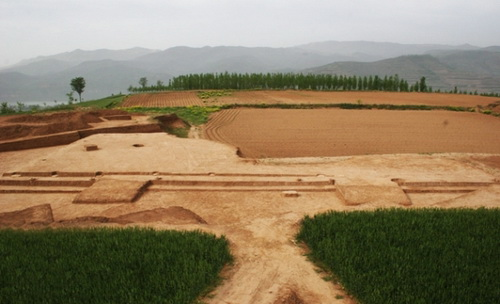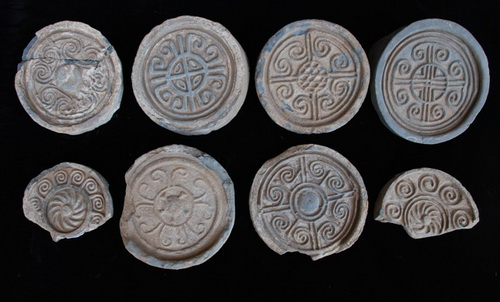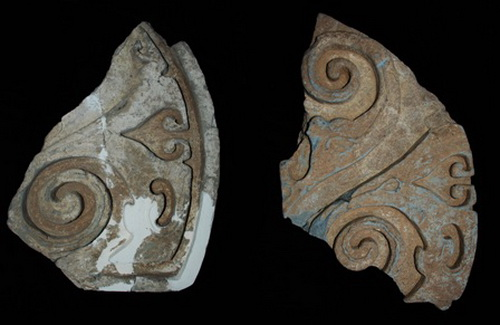A Rich Archaeological Finding from a Qin-Han Site at Shangjialing (Baoji, Shaanxi Province)
In conjunction with the construction of Baoji-Pingliang Highway, the National Bureau of Cultural Relics ordered that an archaeological team consisting of members from Shaanxi Provincial Research Institute of Archaeology, Baoji municipal Archaeological Team, and Qianyang Country Cultural Center be formed to investigate, survey, and excavate a site at Shangjialing from March through May, 2010.
It has been confirmed that the site, functioning as both a traveling palace and a posthouse, was initially built during the Warring States Period and was continued in use through the Western Han. The site measures about 22000 square meters and shows clear signs of its structure, contains, and successive layers. This excavation focuses on two pound-earth foundations (numbered Area I and Area II) and their outer enclosure. The sites is located in Fengjiabao Village (Nanzhai Town, Qianyang County)and can be counted as another important finding along the Qian River after those findings of Qin-Han settlements in Moeryuan (Longxian County), Sunjia Nantou (Fengxiang), and Weijiaya (Baoji), among others.

Area I is situated in the east of the site. Seven hundred square meters have been excavated, revealing some pound-earth architectural foundation below the ground. The foundation measures 32 meters from east to west, 17.7 meters from north to south. The main body of the architecture measures 30.7 meters in length and 15 meters in width. There is a one step stairway built to its east, west, and south. The stairway to its north side has two steps. At the north of the main architecture have survived a row of post holes with space between of 1.15 to 7.3 meters. A row of seven above-ground pottery column bases have survived at the first step. They all have regular shape. Their diameters measures from 33 to 37 centimeters, while the central holes measures 15 or 16 centimeters. They may originally have supported the colonnades. In the south of the building, corresponding to the above-said post holes, are three post holes. Furthermore, at the south step are two post holes. They may also have supported the colonnades. In the east of the main building have been found two pilasters with an interval of 7.6 meters. In addition, a post hole has been identified at the main body of the building with a diameter of more than one meter. It may have belonged to the main pole (duzhu). The column base stone has an irregular shape and is 1.2 meters long, 0.8 meter wide, and 0.45 meter thick. The structure built on the foundation has long been destroyed. Judging from such remains as bricks, tiles, charcoal, red scorched earth as well as earth bricks from layer ③A, it can be inferred that this is an earth embankment construction. Local villagers found some crib rings used for a well at the site in 2006. Each ring is 1.1 meters in diameter and 0.33 in height. They should originally been piled up to form a well tube. Under the well is a drain pipe leading to the valley. The excavation has confirmed that originally these crib rings have been positioned inside the pound earth in the central area of the foundation at Area I. To judge from the local hydrology, no underground water is able to be drilled from such a shallow well and meanwhile, it is impossible to build a well inside the building of such a scale. Thus scholars have surmised that this “well” may have functioned as a cellar for the purpose of refrigerating the food (lingyin).
A rectangular pound earth wall surrounds Area I. The total size inside the wall measures 6400 square meters. The base of the wall measures 2.5 meters, while each layer of the pound earth measures 8 to 10 centimeters.

Area II is situated in the west of the site. It mainly consists of three sections, including the wall in the south, the subsidiary pound earth building, and the main pound earth building. The wall has some turns, parallel the alignment of the foundation of the pound earth structure. The surviving wall is 17.5 meter long and 2.5 meters wide, while each layer of the pound earth is 8 to 10 centimeters thick. Area II shares part of the wall of Area I and the structure of its wall is almost identical with that of the wall in Area I. The purpose of this wall, therefore, is simply to partition the two areas, one for the main buildings and the other for the lesser buildings. Furthermore, the two buildings in Area II can also be classified as the subsidiary and the main. The surviving foundation of the subsidiary building is 23 meters long and 4.8 meters wide. The intact west corner wall of the main building measures 19.7 meters long and 9.2 meters wide. The entire aboveground structure has long been destroyed. The column bases are 0.25 meter above the foundation of the subsidiary building. Some pottery elbow pipes and drain pipes have been found in this area.
Based on the stratigraphical and typological evidence, the foundation in Area I was constructed during the Warring States. Its uses as well as renovation were continued well into the Qin and Western Han Dynasties. The great amount of scorched earth and ashes indicate that the building was discarded after a fire. Building in Area II was abandoned at roughly the same time period.

The large size of the Shangjialing site bespeaks its high rank. It was originally not only situated along the main route linking ancient Longdong area to Guanzhong area, but also located in-between the Qian River and the Huizhong Route. Ancient texts have allowed us to infer that the function of the palace complex at Shangjialing is of a traveling palace kind. Due to the annual imperial inspections and sacrifices in regions to the west of Shangjialing during the Western Han, the site may have functioned as a spot for sojourn. During the reign period of the Wudi Emperor, activities of this sort were largely performed in areas close to the suburbs of Chang’an. This may lead to the demise of the traveling palaces in the country. In addition to functioning as a traveling palace, the site at Shangjialing may have also functioned as a posthouse, a pier, among others.
For the first time, pottery column bases have been found from Shangjialing site. The locations of these bases at the foundations as well as the features of the buildings themselves are important data for us to reconstruct the structure of the traveling palaces and their alike during the Qin and Han. They also provide some significant evidence for understanding the historical “Guanzhong and Tianshui Unity.” (Translated by Wang Yudong)

